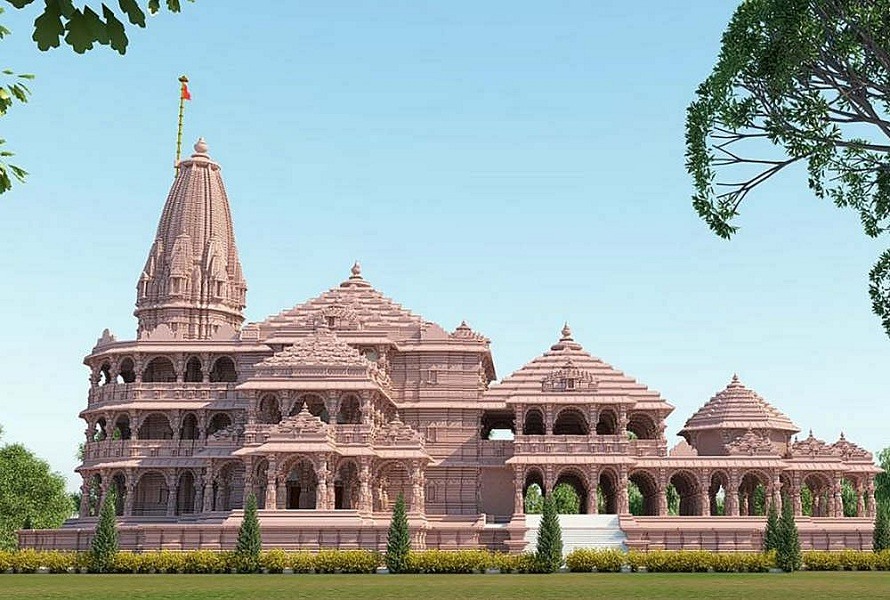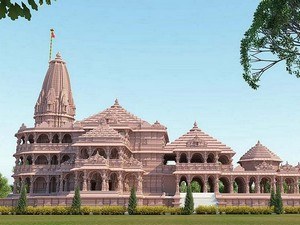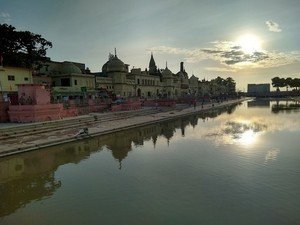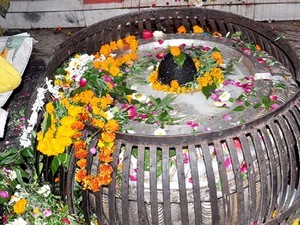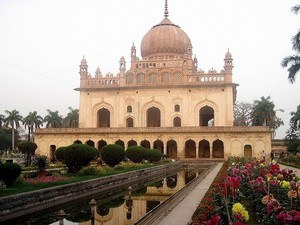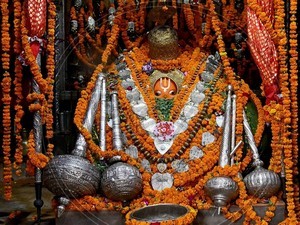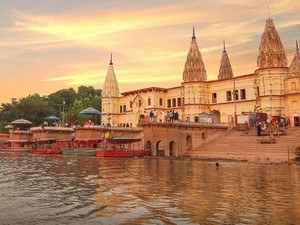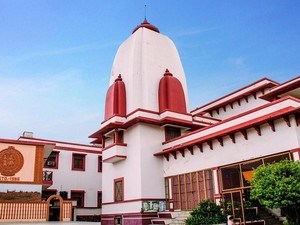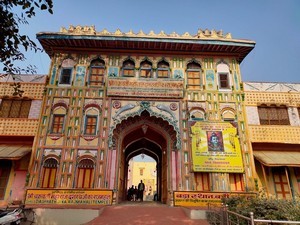Ram Janam Bhoomi, Ayodhya - Timings, Festivals, History, Darshan, Pooja Timings
Photo Credit: Flickr
 #3 of 18 Places to Visit in Ayodhya
#3 of 18 Places to Visit in Ayodhya
 Distance (From Ayodhya Junction): 2 Kms
Distance (From Ayodhya Junction): 2 Kms
 Trip Duration (Including Travel): 1-2 Hours
Trip Duration (Including Travel): 1-2 Hours
 Place Location: In Ram Kot Area
Place Location: In Ram Kot Area
 Transportation Options: Cab / Auto
Transportation Options: Cab / Auto
 Travel Tips: None
Travel Tips: None
About Ram Janam Bhoomi Temple
At a distance of 2 Km from Ayodhya Junction, Ram Mandir or Ram Janam Bhoomi is a sacred temple situated in Ayodhya, Uttar Pradesh. Also known as Shri Ramlalla Mandir, it is one of the popular temples in Uttar Pradesh, and among the must-include places in the Ayodhya tour packages. Although Ayodhya is generally referred to as the birthplace of Shri Ram, there is actually a specific place in Ram Kot Ward of the city where Lord Rama was born. This holy place has been regarded as the first one of the seven most important pilgrimage sites for Hindus in India, and among the must visit places in Ayodhya Darshan.
History & Mythology of Ram Janam Bhoomi Temple
Ram Janam Bhoomi is believed to have been the exact birthplace of the Hindu deity, Lord Ram. The location of the temple has been a focal point of communal tensions between Hindus and Muslims in India, as it was previously the site of the Babri Masjid, constructed between 1528 and 1529. It is thought that the Mughals destroyed a Hindu temple to erect this mosque at the birthplace of Lord Rama. The mosque was subsequently attacked and demolished in 1992 by a group of Hindu nationalists. After decades of conflict, the Ram Janmabhoomi land was transferred to a trust by the Supreme Court of India for the construction of the Ram Temple in 2019. Additionally, an alternative 5 acres of land was allocated to the Sunni Waqf Board for the establishment of a mosque.
The construction of the Ram Mandir in Ayodhya commenced in August 2020 under the leadership of Narendra Modi, the Prime Minister of India. Although the construction may require several years to finalize, numerous individuals continue to visit this temple to pay homage to Lord Rama. On 22 January 2024, Narendra Modi acted as the chief patron of the rituals for the occasion and conducted the consecration of the temple. The temple complex is being overseen by the Shri Ram Janmabhoomi Teerth Kshetra Trust.
Architecture of Ram Janam Bhoomi Temple
Sri Ram Mandir in Ayodhya has been constructed in the traditional Nagar style. The temple in Ayodhya, was designed by chief architect, Chandrakant Bhai Sompura, whose grandfather, Prabhakarji Sompura, had designed the Somnath Temple, along with his son, Ashish Sompura. It has a length (east-west) of 380 feet, a width of 250 feet, and a height of 161 feet. It is three-storied, with each floor being 20 feet tall. There are five Mandaps or halls. The entrance on the east would be built in the Gopuram style, which represents the temples of the south. The walls of the temple would display artworks depicting the life of Lord Rama. The sanctorum of the mandir would be octagonal-shaped while the structure perimeter would be circular. At the four corners of the compound, there are four temples - dedicated to the Sun god, goddess Bhagwati, Lord Ganesha, and Lord Shiva. The temple of Maa Annapurna is on the northern side, while a Hanuman temple is on the southern side.
Interestingly, no iron is used anywhere in the construction of Ram Mandir in Ayodhya. The foundation of the Ayodhya Ram temple has been constructed with a 14-meter-thick layer of roller-compacted concrete (RCC), giving it the appearance of artificial rock. A 21-foot-high plinth has been constructed using granite for protection against ground moisture. The core of the temple is built using pristine white Rajasthan Makrana marble. Karnataka's Charmouthi sandstone has been used to carve out the exquisite idols of the deities. On the other hand, pink sandstone from Rajasthan's Bansi Paharpur has been used for imposing figures on the entrance gate.
The Ram Lalla idol consecrated at Ayodhya's Ram Temple has been named 'Balak Ram' as it resembles the deity of a five-year-old boy. The 51-inch statue was crafted by sculptor Arun Yogiraj from Mysuru, Karnataka. The idol is hewn from a three-billion-year-old azure-coloured Krishna Shila (black schist) that was extracted from Gujjegowdanapura in Jayapura Hobli, HD Kote Taluk of Mysuru. The idol is adorned with Banarasi fabric, donning a yellow dhoti and a red 'pataka' or 'angavastram.' The actual idol found in 1949 has now been positioned before the newly consecrated idol. On every Ram Navami at noon, a system of mirrors and lenses will focus the sun's rays on Ram Lalla's idol in the sanctum.
Festivals of Ram Janam Bhoomi Temple
The Shri Ram Janmabhoomi Mandir located in Ayodhya observes numerous festivals throughout the year. The Ram Navami festival, which takes place in March-April, commemorates the birth of Lord Rama and is a significant occasion in Ayodhya, featuring grand celebrations and processions. Diwali is celebrated with immense enthusiasm and splendor in October-November, as it signifies the return of Rama, Sita, and Lakshmana to Ayodhya following their period of exile. Other prominent festivals held at the Ayodhya Ram Mandir include Shravan Jhoola Mela, Parikrama Mela, Rathyatra, Saryu Snan, Ram Vivah, and Ramayan Mela. Additionally, the first anniversary of the consecration of Ram Lalla, referred to as 'Pratishtha Dwadashi,' is also observed.
Ram Janam Bhoomi Temple Dress Code & Other Restrictions
Visitors intending to go to the Ayodhya Ram Mandir Temple must adhere to a strict dress code. Men are advised to wear a dhoti with an angavastram or long trousers paired with shirts, while women are encouraged to wear Sarees, Salwar Kameez, or other traditional garments that sufficiently cover their shoulders and legs. It is advisable to refrain from wearing Western attire such as shorts, skirts, and sleeveless tops.
The Ram Janam Bhoomi Temple welcomes individuals of all faiths, fostering an inclusive atmosphere for people from diverse backgrounds to immerse themselves in Hindu culture and spirituality.
Ram Janam Bhoomi Temple Timings
Monday: 6 AM - 12 PM & 1 PM - 10 PM
Tuesday: 6 AM - 12 PM & 1 PM - 10 PM
Wednesday: 6 AM - 12 PM & 1 PM - 10 PM
Thursday: 6 AM - 12 PM & 1 PM - 10 PM
Friday: 6 AM - 12 PM & 1 PM - 10 PM
Saturday: 6 AM - 12 PM & 1 PM - 10 PM
Sunday: 6 AM - 12 PM & 1 PM - 10 PM
Ram Janam Bhoomi Temple Entry Fee
Entry is Free
Special Darshan & VIP Darshan need Free Pass (Online)
Best Time to Visit Ram Janam Bhoomi Temple
The best time to visit Ayodhya Ram Mandir is from October to March. Although it gets fairly cold during the winters, this is the best time when you can explore the temple as well as the holy city without getting tired. The summers are dry, sunny, and humid, so better to avoid traveling to Ayodhya around this time. Monsoons are moderate with a decent amount of rainfall. If you want to witness the grand celebrations, then plan your trip during the Ram Navami festival.
How to Reach Ram Janam Bhoomi Temple
About 151 Km from Ayodhya, Chaudhary Charan Singh International Airport in Lucknow is the nearest airport that has direct flights from all major cities in India such as Delhi, Mumbai, Kolkata, Patna, Bangalore, Raipur, Patna, Ahmedabad, Chennai, Hyderabad & Pune. Ayodhya Junction Railway Station is connected by daily trains to the cities in Uttar Pradesh like Lucknow, Kanpur, Gorakhpur, Allahabad, Varanasi, and Delhi along with Bangalore, Mumbai, Pune, Hyderabad, Bairelly, Jamshedpur, Chhapra, Farrukhabad, Chennai, Rameshwaram, Darbhanga, Ahmedabad, Muzaffarpur, Surat, Kolkata, Jammu Tawi, Kota, Patna, Bhopal, Dhanbad, Kota, Surat, Udaipur, and Jaipur. Ayodhya is well connected by bus from the neighboring cities in the state. One can reach Ram Janam Bhoomi Temple by hiring a cab, or an auto-rickshaw from all parts of the city of Ayodhya.



